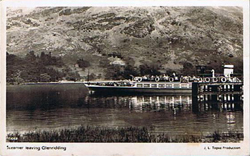 The Raven on Ullswater
The Raven on Ullswater
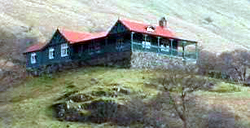
The Bungalow
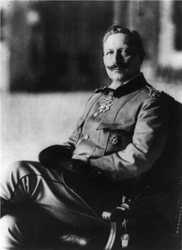
The Kaiser
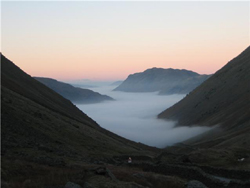
View from Kirkstone Pass
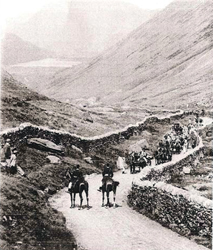
Crossing Kirkstone Pass
World War I was a military conflict that lasted from 1914 to 1918 and involved most of the world's great powers assembled in two opposing alliances. More than seventy million personnel including sixty million Europeans were mobilised in one of the largest wars in history. More than fifteen million people were killed .
In the years leading up to the war the then German Kaiser Wilhelm II visited Lakeland on a number of occasions from 1895 onward staying with The Earl of Lowther and touring the district as well as cruising on Lake Ullswater. For one of his visits, the Raven had her decks painted yellow and was used as a Royal Yacht, the Raven still sails Ullswater today. The Kaiser met Bowman (who was currently hunting the Ullswater Foxhounds prior to his first retirement) and may have hunted with him for he apparently slipped Bowman a fiver (family anecdote).
The Kaiser also shot deer in the nearby Martindale Deer Forest and a large bungalow was constructed for him and his entourage in the 1880s. This same bungalow is available today as a holiday let.
On one occasion the Kaiser and his retinue travelled over the Kirkstone Pass, the horses being well lathered on arrival at their destination apparently. My grandfather and two of my great uncles went to see him pass by. One of my great uncles told me the tale ending with the words “but we never thowt (thought) we’d be fighting the bugger."
Beatrix Potter also watched the procession and recorded the following entry in her diary.
“Tuesday August 15th 1895. We consumed three whole hours waiting to see the Emperor, not very well worth it. I had seen him in London. I think he is stouter. I was not particularly excited. I think it is disgraceful to drive fine horses like that. First came a messenger riding a good roan belonging to Bowness, which we could hear snorting before they came in sight, man and horse both dead-beat. He reported the Emperor would be up in ten minutes, but it was twenty.
The procession consisted of a mounted policeman with a drawn sword in a state approaching apoplexy, the red coats of the Quorn Hunt, four or five of Lord Lonsdale’s carriages, several hires and spare horses straggling after them. There were two horses with an outside rider to each carriage, splendid chestnuts thoroughbreds floundering along and clinking their shoes.
They were not going fast when we saw them, having come all the way from Patterdale without even stopping at Kirkstone to water the horses, to the indignation of mine host, and an assembly of three or four hundred who had reckoned on this act of mercy. I think his majesty deserved an accident and rather wonder he didn’t have one considering the smallness of the little Tiger sitting on the box to work the break.
The liveries were blue and yellow and the carriages much yellow singularly ugly low tub. With a leather top to shut up sideways. The Emperor, Lord Lonsdale and two ladies in the first, Lady Dudley, etc. in the second.
There was a considerable crowd and very small flags. German ones bad to get at short notice, but plenty of tricolours. Lord Lonsdale is red headed and has a harum-scarum reputation, but according to Mr Edmondson, less 'stupid' than his predecessor whom he had seen 'Beastly droonk' in the road on a Sunday morning."
Using the “Baily's” from those years, The Westmorland Gazette archive and some other material I will attempt to give an account of how the War affected the fell packs, starting in the years leading up to the War.
1913–1914
At this time there were five fell packs, the Lunesdale, as we know them were not formed until 1946. The area hunted by these five packs was broadly the same as today.
The Blencathra. The Master (from 1903) was The Rt. Hon James W. Lowther, Speaker of the House of Commons. From 1894 Jim Dalton had hunted the pack. There were 12 couple of hounds that were out three days a week. Minimum subscription 2s 6p and the total subscription per year was £120. Hounds belonged to the Committee and subscribers.
The Coniston. The Master Bruce Logan had been in post since 1908, his huntsman was George Chapman who hunted 12 couple of hounds three days a week, the hounds belonged to the Master.
Eskdale and Ennerdale. Master (from 1910) W. C. Porter who also hunted the 15 couple of hounds two days a week, again the hounds belonged to the Master. The hunt itself was manged by a Committee and any subscription was accepted, they varied between 10 shilling to £3 3s.
The Mellbrake (Baily’s spelling). Master (from 1865) John Benson. Huntsman Jonathan Banks with Anthony Barnes as Whipper In. 12 couple of hounds hunting two days per week. A private pack belonging to John Benson who hunts the country at his own expense.
Ullswater. Master (from 1910) W. H. Marshall. Huntsman G. Salkeld. 13 couple of hounds. Hunting three days a week. A meet of the Coniston foxhunds as recorded in The Lakes Herald, 17th April 1914.
On Monday the hounds met at the Grove Farm, and took a drag at Broad End, proceeding through Woundle Head and Sad Gill to Broad How, where Reynard was unkennelled. He took across the brest and through Thresthwaite Mouth for Blue Ghyll; turning right handed through Park Fell Head for Caudale Moor, thence down into Hartsop, swinging right handed by Grey Crag, back to Thresthwaite Mouth and Broad How, where it came on so misty it was impossible to make out whether hounds had killed or holed their fox.
As can be seen the fell packs ran on a very small income, compared for example to The Essex a mounted pack with 50 couple of hounds hunting 4 days per week, whose Master was guaranteed £3300 per year with a further sum subscribed to meet poultry claims etc. The minimum subscription is 30 gs but there was no cap! Or the Meynell with 60 couple of hounds hunting again 4 days per week whose Master was guaranteed £2250 per anum.
1915–1916
Blencathra. Nothing had changed, James Lowther remained as Master with Jim Dalton as huntsman and the subscription remained the same as the previous year as did the 12 couple of hounds and number of days per week hunted.
Coniston. The annual balance sheet shows the year began with an adverse balance of £11 0s 5d, reduced to £3 18d by special donations of £7 2s. Total subscriptions came to £109 2s. The main item being £55 12s 1d for the huntsman his clothes and licence. £56 12s 1d for keep of the hounds and £6 3s for sundries. There were 57 subscribers and 29 hound walkers.
Eskdale and Ennerdale. The only change as recorded by Baily's for the season was a reduction in the number of hounds from 15 couple to 12 ½, presumably as the effect of the War began to be felt.
Melbreak. As the previous season.
Ullswater. As the previous season. However, ”February 1916 produced a 20lb fox of silver grey at Nethermost Pike, a species nearly extinct these days”. (Skelton 1921)
The fell packs were relied upon to help control the predation of foxes which became increasingly detrimental to the war effort. Not every pack managed to survive though, for whatever reason; one of the packs to disband due to the War was The Mendip (Mr Tiarks) whom Baily's records gave up “until the War is over when a fresh start will be made”.
1916–1917
Blencathra. Again things remained the same with the “Cathra”.
Coniston. As it did with the Coniston
Eskdale and Ennerdale. Carried on pretty much the same, however Mrs Nicholson became Hon Sec taking over from her son T Nicholson who had been Secretary since 1913 but was now in France.
Melbreak. John Norman joined Anthony Barnes as whipper in.
Ullswater. Joe Bowman returned as Huntsman for his second spell after retiring in 1911 (he continued until 1924), replacing G Salkeld, who (according to The Reminiscences of Joe Bowman by Skelton 1921) left “due to the exigencies of war”.
Bowman hunted 3 days three days per week with 13 couple of hounds.
At the Mardale shepherds' meet that year, a fox went to ground in the peat holes above Wolf Crag. Skelton, 1921, takes up the story,
“the first follower on the scene J. Teasdale found two or three hounds had attacked their kennel comrade Mariner, who died soon after. The cause was put down to excitement in trying to get at the fox. Terriers often scrap when underground, sometimes with fatal result, but such quarrelling is rare amongst the fell hounds.”
The following report is of a Coniston Foxhounds hunt from this time:
On Wednesday last week the meet was at Helm Crag, Grasmere. A fox was unkennelled at Horn Crag and led over into Langdale. It eventually holed in Blakerigg, from where it was drawn. He was given another chance, which he made good use of, and putting in some doubling work was ultimately lost.
There was a good field out at the meet at the kennels on Monday. Game was unkennelled at Dove Crag and provided an excellent run to Hartsop and Deepdale Hall and after three hours was lost in Deepdale Head.
Lakes Herald, 7th January 1916
Foxes were an increasing problem for farmers as the war continued as this report shows:
In the neighbourhood of High Wray of late, several farmers have had poultry worried, presumably by foxes. During the weekend Mr John Rigg of Randypike, had 18 hens and a cockerel worried in one of his hen houses, the fox having got through the poultry entrance, which had been left open. The hens had been carried away to different places and a good many feathers torn off.
Westmorland Gazette, 3rd November 1917
1918–1920
Blencathra. Almost unchanged with the exception of the Whip W.M Atkinson is recorded as being with H.M Forces.
Coniston. The balance sheet for the 1918 / 1919 season showed a deficit of £56 19s. Subscriptions were £141 19s 6d. The huntsman’s wage was £56 plus his uniform and insurance. Cost of keeping the hounds was £65 5s 9d to include meal and license. There were 18 people listed as hound walkers.
Eskdale and Ennerdale. The 12-½ couple of hounds carried on for the remainder of the war years, Mr T Nicholson is shown as Hon Sec.
Melbreak. Robinson Mitchell is shown as taking on the duties of Master from 1917, also shown, as Masters are Captain E. A. Iredale and D. B. Robinson with Richard Head as huntsman.
Ullswater. Again unchanged.
A Coniston Hunt of 1918
Tuesday the meet was at Grove Farm, Ambleside. Striking a drag immediately they crossed for the Screes, where he was unkennelled, going out all the length of the rough ground and out by Kirkstone Cove by Dod Bields, back by Scandal and Pinch Crags, ran to ground in Petts Quarries, where he refused to bolt, and had to pay the penalty. During this round five of the hounds must have broken away with a fresh fox, and were first seen by Anthony Benson coming through Fairfield making for Rydal Head. Racing him through by Buckstones they rolled him over just above Rydal Hall, where Anthony Benson was again the lucky man to pick him up. This proved to be a fine dog fox of 17 ½ lbs in weight.
Westmorland Gazette, 14th December 1918
Not all the packs that folded because of the war were outside the Lakes; this entry from the Whitehaven News and Star makes interesting reading.
WORKINGTON Hall’s pack of foxhounds was discontinued in 1915. The Curwen pack was no more.
It’s not so much that Curwen had lost interest in hunting, he hadn’t; although he didn’t himself take part in any hunts.
But there was a war on, which caused a rearranging of priorities.
Many of the hunt’s supporters were on active service in France. Captain E A Iredale, master of the hunt, was in France with the 5th Border. Two other key members, Captain Massey and Captain T W Highet, were away fighting in the Dardanelle’s. So numbers were down.
What probably caused Curwen to break up the pack was the death in France of Major Broadley-Smith, the man Curwen relied on most to run the pack.
It hadn’t been going long, only about eight years. But Broadley-Smith had succeeded in bringing together a first rate pack. The original one had consisted of a few old Thurstonfield hounds plus a few bloodhounds and griffons.
Over the years he’d successfully bred in characteristics from other packs – Blencathra, Ullswater, Melbreak, Scale, Ennerdale and Coniston but it was the end of an era.
The dogs were no doubt absorbed in other packs. Broadley-Smith’s terriers were reportedly left to William Porter, the master of the Eskdale and Ennerdale packs.
And what of the horses belonging to the ex-hunt members? The chances are that they ended up in France. There was a shortage of trained horses there and the Army had been forced to import suitable animals from Canada.
It wasn’t unusual for members of the officer class to take their own horses to war with them, horses well used to the rough and tumble of the hunting field. Many horses perished in the war but some survived.
So, in 1919, we find that Lieut-Colonel Mason was still riding Dragon, a hunter, which he’d taken with him to France. It was a horse which had belonged to Mr St George Curwen.
Cartmell was a horse which had been ridden in the hunting field by C F Watson but Major Massey (a promoted Captain Massey?) had taken it off to France and was still riding it in January 1919.
I can only assume that both riders and horses returned to Blighty and once more showed their paces on the hunting field.
Finally, after the war the men who returned never forgot their comrades who did not, as this entry from The West Cumberland Times 14th November 1931 records:
The “John Peel” Blencathra hunt was hunting on Skiddaw on Wednesday, and huntsman and followers observed the two minutes silence up on the fells of Skiddaw amid the wreathing mist.
Thanks to Caroline and Tracy at Baily’s, William and also Clara and the staff of the Armitt Library Ambleside for their help in putting this piece together.
References:
The History of the Coniston Foxhounds
1825 – 1925 by Neil Salisbury
Reminiscences of Joe Bowman by W. C. Skelton, 1921
Beatrix Potter's Journal (abridged with an introduction by Glen
Cavalero), 1996
